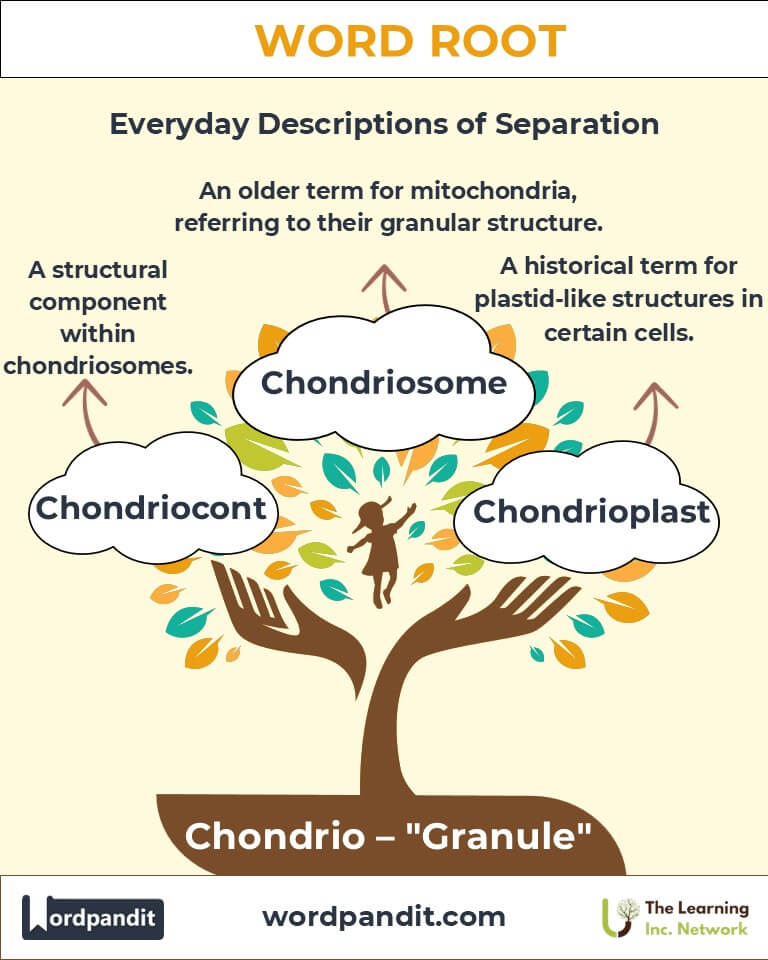Chondrio: The Granular Foundation of Cellular Life
Discover the fascinating world of the root "Chondrio," meaning "granule," which serves as the basis for key terms in cell biology. From "chondriosome" to "mitochondria," this root connects us to the microscopic structures essential for energy and life at the cellular level.

Table of Contents
- 1. Introduction: The Essence of Chondrio
- 2. Etymology and Historical Journey
- 3. Mnemonic: Unlocking the Power of Chondrio
- 4. Common Chondrio-Related Terms
- 5. Chondrio Through Time
- 6. Chondrio in Specialized Fields
- 7. Illustrative Story: Chondrio in Action
- 8. Cultural Significance of Chondrio
- 9. The Chondrio Family Tree
- 10. FAQs About the Chondrio Word Root
- 11. Test Your Knowledge: Chondrio Mastery Quiz
- 12. Conclusion: The Living Legacy of Chondrio
1. Introduction: The Essence of Chondrio
What is the powerhouse of the cell? If you answered "mitochondria," you’ve already encountered the essence of the root "chondrio." Pronounced kon-dree-oh, this root means "granule," a fitting descriptor for the tiny, yet vital, structures within cells. From its role in energy production to its involvement in cellular organization, "chondrio" underscores the granularity of life itself.

2. Etymology and Historical Journey
The word root "chondrio" stems from the Greek chondrion (meaning granule or small grain), a diminutive of chondros (grain or cartilage). It first gained prominence in scientific terminology during the 19th and 20th centuries as scientists identified granular structures within cells, such as the mitochondria and chondriosomes. This root remains foundational in the lexicon of cellular biology.
3. Mnemonic: Unlocking the Power of Chondrio
Imagine a handful of grains representing cells' tiny but essential components. Each grain powers a massive machine, illustrating the granularity of life and the energy within.
Mnemonic Device: "Chondrio: Granules of life, powering the cellular engine."
4. Common Chondrio-Related Terms
- Chondriosome (kon-dree-oh-some): An older term for mitochondria, referring to the granular structure within cells.
Example: "Scientists once referred to mitochondria as chondriosomes due to their granular appearance." - Mitochondria (my-to-kon-dree-uh): Organelles that generate energy for cellular functions.
Example: "Mitochondria are critical for producing ATP, the energy currency of the cell." - Chondrioplast (kon-dree-oh-plast): A term used historically to describe plastid-like structures in certain cells.
Example: "The chondrioplast was once thought to play a role similar to that of mitochondria." - Chondrocyte (kon-droh-site): A cell found in cartilage, containing granular cytoplasm.
Example: "Chondrocytes are responsible for maintaining cartilage structure and function." - Chondroma (kon-droh-mah): A benign tumor composed of cartilage-like tissue.
Example: "The surgeon successfully removed the chondroma without complications."
5. Chondrio Through Time
- Chondriosome to Mitochondria: Early researchers identified granular organelles in cells, naming them chondriosomes. This term later gave way to "mitochondria," emphasizing their dual roles in energy production and structural organization.
- Granules to Powerhouses: Initially thought to be simple granules, mitochondria were later revealed to harbor complex biochemical machinery essential for life, reflecting an evolution in our understanding of "chondrio."
6. Chondrio in Specialized Fields
- Cell Biology: The study of mitochondria highlights their critical role in ATP synthesis and apoptosis regulation.
- Histology: Chondrocytes are key in understanding cartilage health and repair mechanisms.
- Medicine: Chondroma research aids in diagnosing and treating cartilage-related tumors.
- Genetics: Mitochondrial DNA research has advanced our knowledge of hereditary diseases and evolutionary biology.
7. Illustrative Story: Chondrio in Action
Dr. Elena Ramirez, a cell biologist, discovered a link between mitochondrial dysfunction and a rare neurological disorder. By analyzing the chondriosomal structures in affected cells, she developed a therapy that restored energy production, giving patients new hope. Her work highlighted the profound importance of these "granules of life."
8. Cultural Significance of Chondrio
The study of mitochondria, inspired by the root "chondrio," has revolutionized our understanding of health and disease. Beyond science, the phrase "mitochondria is the powerhouse of the cell" has entered popular culture, becoming a meme that humorously symbolizes basic knowledge.

9. The Chondrio Family Tree
- Chondro- (Cartilage): Examples include chondritis (inflammation of cartilage) and chondrocyte.
- Plast- (Molded or Formed): Examples include plastid and cytoplast.
- Mito- (Thread): Examples include mitosis and mitochondria.
FAQs About the Chondrio Word Root
Q1: What does "chondrio" mean, and why is it significant?
A: "Chondrio" means "granule," originating from the Greek chondrion. It is significant because it describes the granular structures within cells, such as mitochondria, which play critical roles in energy production, cellular organization, and overall life processes. Understanding this root helps contextualize cellular biology's foundational concepts.
Q2: What is a chondriosome, and how does it relate to mitochondria?
A: A chondriosome is an older term for mitochondria, referring to their granular appearance. Mitochondria are essential organelles that generate ATP, the energy currency of the cell. The shift from "chondriosome" to "mitochondria" reflects a deeper understanding of their complex roles beyond their granular structure.
Q3: Are mitochondria only involved in energy production?
A: No, mitochondria have diverse functions beyond energy production. They regulate cellular metabolism, apoptosis (programmed cell death), and calcium storage. They also produce signaling molecules like reactive oxygen species (ROS), which have roles in cellular communication and stress responses.
Q4: How does "chondrio" connect to "chondro," which refers to cartilage?
A: Both "chondrio" (granule) and "chondro" (cartilage) derive from the Greek chondros, meaning "grain" or "cartilage." While "chondrio" emphasizes granularity within cells, "chondro" pertains to cartilage, a tissue made of chondrocytes, which also display granular cytoplasmic features.
Q5: Why are mitochondria called the "powerhouse of the cell"?
A: Mitochondria are called the "powerhouse of the cell" because they produce ATP through oxidative phosphorylation. ATP is the primary energy source for cellular processes like muscle contraction, active transport, and biosynthesis. This energy generation is vital for the survival and function of all eukaryotic cells.
Q6: What is mitochondrial DNA (mtDNA), and why is it important?
A: Mitochondrial DNA is a small, circular DNA molecule found within mitochondria. It encodes essential genes for mitochondrial function and is inherited maternally. Studying mtDNA provides insights into evolutionary biology, hereditary diseases, and forensic science.
Q7: What is a chondroma, and how is it treated?
A: A chondroma is a benign tumor composed of cartilage tissue. While generally noncancerous, larger chondromas can cause discomfort or impede movement and may require surgical removal. Diagnosis involves imaging techniques like X-rays or MRIs, often followed by a biopsy.
Q8: What role do chondrocytes play in the body?
A: Chondrocytes are specialized cells found in cartilage. They maintain the extracellular matrix by producing collagen and proteoglycans, ensuring cartilage's resilience and flexibility. These cells are crucial for joint health and are a focus in treatments for arthritis and cartilage damage.
Test Your Knowledge: Chondrio Word Root Quiz
1. What does "chondrio" mean?
2. Which term refers to the powerhouse of the cell?
3. What is a chondroma?
4. What is the primary function of mitochondria?

12. Conclusion: The Living Legacy of Chondrio
The root "chondrio" bridges the microscopic and the monumental, encapsulating the granules that power life. From the energy-generating mitochondria to the cartilage-forming chondrocytes, "chondrio" highlights the intricate beauty of biology. As science progresses, this root will continue to inspire discoveries that illuminate the building blocks of life.











